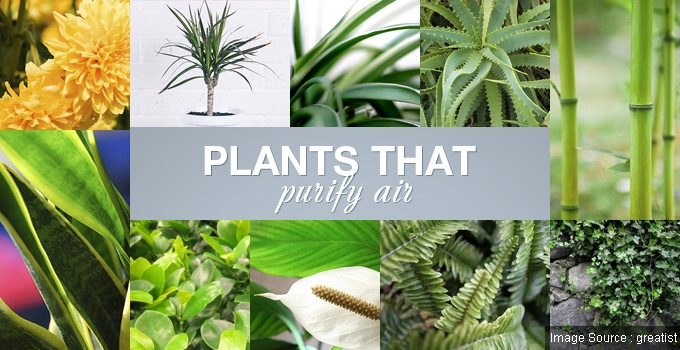According to a research report from the WHO (2016), half of the world’s most polluted cities in the world are in India. Going by the urban air quality database India ranks among the lowest in terms of air pollution. This, however, is no reason to despair. We the people can ensure that our homes, offices, and public spaces are clean. Growing indoor plants that act as natural air purifiers is a great way to clean up our immediate environment. Here are 10 indoor plants that can easily be found in India and act as great air purifiers.
Chrysanthemum – Now here’s a plant that we Indians typically love in our gardens. The Chrysanthemums belong to the Asteraceae family and the colours of these blooms are a visual treat. These plants are best grown indoors while the flowers are blooming. Chrysanthemums rank high on air purification and eliminate ammonia, formaldehyde, xylene, and other air toxins.
Money Plant – The Money Plant (Epipremnum Aureum), often called Devil’s Ivy, is a common sight in many Indian homes. It is said to attract positive vibrations and improve the Feng Shui of your household. Be as that may, Money Plants are low maintenance, easy to grow, and excellent in eliminating formaldehyde from the air.
Snake Plant – The Snake Plant, also sometimes called Mother-in-Law’s Tongue (Sansevieria trifasciata) is another common sight in Indian homes. Not only is it very easy to grow, it is very resistant to infections, and difficult to kill. Snake Plant is also one of the best houseplants to eliminate benzene, nitrogen oxide, and other airborne toxins such as formaldehyde, and trichloroethylene. The plant requires very little sunlight.
Areca Palm – Areca Palm or Golden Cane Palm (Chrysalidocarpus lutescens or Dypsis lutescens) with its fanned out leaves and beautiful green colour is another favourite when it comes to living rooms, patios, balconies, and bedroooms. Not only does it remove toxins such as formaldehydes, benzene, and carbon monoxide from the air, it is also an excellent natural humidifier. The Areca Palm is also very easily grown in small pots but grow to a considerable height.
Aloe Vera – The Aloe Vera plant of the Aloe genus is already quite popular for its medicinal properties. Most people grow it to extract the sap which is a natural moisturizer and a soothing salve. It is a sun-loving plant and can be easily grown in window sills. It also helps purify the air by removing benzene and formaldehydes and gases eliminated by chemical purifiers. Check more benefits of Aloe Vera.
Dracaena – The Dracaena (Janet Craig) is another plant that flourishes indoors with minimal sunlight and care. It easily removes formaldehydes, benzene, xylene, and trichloroethylene from the air. Many varieties of the Dracaena are easily found in tropical regions. Parts of the plant may, however, be toxic to pets and will need care.
Peace Lily – The Peace Lily (Spathiphyllum) is a native of the Americas and Southeast Asia. It is a favourite indoor plant grown commonly in large office spaces and hotels due to the beautiful flowers that bloom on the plant. Easy maintainance and removal of Ammonia, formaldehydes, benzene, and trichloroethylene make it an excellent choice as an air purifying plant.
English Ivy – If you’re looking for a climber to beautify your home or office space and a plant that will also act as an air purifier, the English Ivy or the Hedera Helix is your best bet. It removes formaldehydes, benzene, and trichloroethylene but may also be toxic to dogs, cats, and pets.
Flamingo Lily – The Flamingo lily (Anthurium andraeanum) is often featured in bouquets and Indian householders looking for low care indoor plants are increasingly warming up to its benefits as an air purifier. The plant cleans out the formaldehyde, xylene and toluene, and ammonia in the air.
Spider Plant – The Spider Plant (Chlorophytum comosum) is a versatile indoor plant. It requires very little sunlight and water and can be grown in small pots. It can be used to decorate the windows, side tables, floor spaces, and patios as well. This flowering perennial herb sports long ribbon like leaves and cleans the air of formaldehyde, xylene, and toluene.
All these plants were featured in the NASA Clean Air Study – a research by NASA to clean the air in space stations. The research suggests that for optimum cleaning we should have at least one of these plants for every 100 square feet of office or home space.





